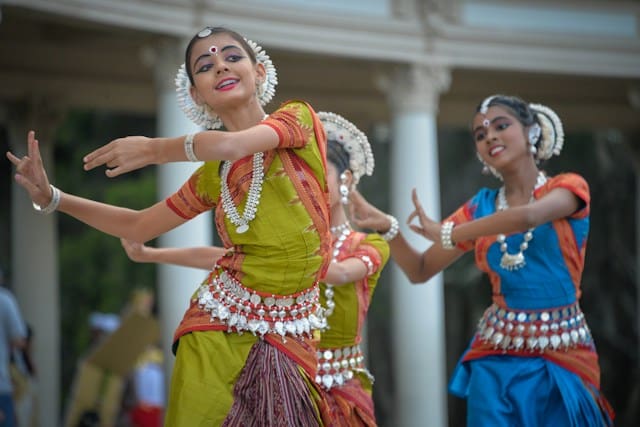20 Fascinating Indian Culture & Traditions
As I walk the vibrant streets of India, I am awestruck by the kaleidoscope of colors, scents, and sounds surrounding me. This land is a treasure trove of rich and diverse cultural traditions that have been passed down through generations. From the enchanting festivals to the mesmerizing dance forms, each aspect of Indian culture resonates with a deep sense of history and spirituality.
In this article, we will embark on a captivating journey through 20 fascinating Indian cultures and traditions that make this country unique. So, fasten your seatbelts and prepare to immerse yourself in a tapestry of customs, rituals, and practices that will leave you spellbound. Let us uncover the hidden gems of Indian heritage, as together we celebrate the mosaic of colors that define this great nation.
1. Diwali
Diwali, also known as Deepavali, is one of the most popular festivals in India. It is a five-day festival that is celebrated with great enthusiasm and fervor. The festival celebrates the victory of light over darkness and good over evil. It is believed that on this day, Lord Rama returned to Ayodhya after a long exile of 14 years. The festival is marked by the lighting of oil lamps, called diyas, which are placed in homes and temples. People also decorate their homes with colorful rangolis, which are beautiful patterns made with colored powders. Firecrackers are also a common sight during Diwali, as they are believed to drive away evil spirits. The festival is a time for families and friends to come together, exchange gifts, and enjoy festive meals.
2. Holi
Holi, also known as the Festival of Colors, is a vibrant and joyous festival celebrated in India and other parts of the world with a significant Hindu population. It is celebrated on the day after the full moon in the month of Phalgun, which usually falls in March. The festival marks the arrival of spring and is a time of joy and merriment. During Holi, people throw colored powders and water at each other, playfully smearing each other’s faces and clothes with bright colors. It is a time when people let go of inhibitions and social norms, coming together as equals to celebrate and have fun. The festival also signifies the triumph of good over evil, as it is associated with the legend of Prahlad and Holika. Holi is a time for people to forget their differences, forgive and forget, and come together in a spirit of love and unity.
3. Yoga
Yoga is a spiritual, mental, and physical discipline that originated in ancient India. It is a practice that aims to bring harmony between the body, mind, and spirit. Yoga combines physical postures, known as asanas, with breathing exercises, meditation, and ethical principles to promote overall well-being. Yoga is widely practiced in India and has gained popularity globally for its numerous health benefits. It is known to improve flexibility, strength, and balance, as well as reduce stress and promote mental clarity. Yoga is not just a physical exercise but a way of life that encompasses both physical and spiritual aspects. It is not limited to any particular religion or culture and can be practiced by people of all ages and backgrounds.
4. Mehndi
Mehndi, also known as henna, is the art of applying intricate designs on the hands and feet using a paste made from dried henna leaves. It is an important part of Indian culture, especially during weddings and festivals. The application of henna is seen as a symbol of beauty, celebration, and good luck. The designs can range from simple patterns to intricate motifs, and they are believed to bring blessings and ward off evil spirits. Mehndi is not just a form of body art but also a social and cultural activity. During weddings and festivals, women gather together to have mehndi applied on their hands and sing traditional songs. Mehndi is also considered a form of self-expression, as the designs often reflect the individual’s personality and style.
5. Bollywood
Bollywood is the informal name given to the Hindi-language film industry based in Mumbai, India. It is the largest film industry in the world in terms of the number of films produced, surpassing Hollywood in terms of ticket sales. Bollywood films are known for their colorful costumes, elaborate song and dance sequences, and dramatic storylines.
They often blend elements of romance, comedy, action, and drama. Bollywood has a huge fan following not only in India but also across the globe, with its films being dubbed and subtitled in various languages for international audiences. Bollywood movies are a reflection of Indian culture and society, showcasing a mix of traditional and modern values. Bollywood has also played a significant role in promoting Indian culture and traditions worldwide, with its films often showcasing Indian festivals, traditions, and values.
6. Ayurveda
Ayurveda is an ancient system of medicine that originated in India over 6,000 years ago. It is based on the belief that health and wellness depend on a delicate balance between the mind, body, and spirit. Ayurveda emphasizes personalized treatments and approaches to optimize overall well-being. It uses natural remedies, herbal medicines, dietary adjustments, and lifestyle practices to restore and maintain balance in the body. Ayurveda focuses on the prevention of diseases, rather than just treating symptoms. It has gained recognition worldwide for its holistic approach to health and its emphasis on individualized care.
7. Namaste
Namaste is a traditional Indian greeting that is widely used in India and other parts of Asia. It involves bringing the palms together in front of the chest, fingers pointing upwards, and bowing the head slightly. The word “Namaste” is derived from Sanskrit and translates to “I bow to the divine in you“. It is a gesture of respect, humility, and acknowledgment of the spiritual essence that resides within each individual. Namaste is often accompanied by saying the word aloud and offering a warm and respectful greeting. It is commonly used when meeting someone, saying goodbye, or showing gratitude.
8. Saree
The saree is a traditional Indian garment that has been worn by women for centuries. It is a long piece of fabric, usually between five to nine yards, that is draped around the body in various styles. The saree showcases the beauty and grace of Indian women and is considered the epitome of elegance and femininity. It is worn for both casual and formal occasions, and the choice of fabric, design, and draping style varies depending on regional and cultural preferences. The saree is often paired with a blouse and accessorized with jewelry, creating a complete and stunning ensemble. It is not just a clothing item but a symbol of Indian culture and tradition, reflecting the diversity and richness of the country.
9. Classical Indian Music
Classical Indian music has a long and rich history, dating back thousands of years. It is based on a system of ragas (melodic scales) and talas (rhythmic cycles). Indian classical music is known for its improvisational nature, with musicians often taking the structure of the raga and improvising within its boundaries.
It is a highly complex and sophisticated form of music, requiring years of dedication and training to master. Classical Indian music is divided into two main traditions – Hindustani (North Indian) and Carnatic (South Indian) music. Both traditions have their unique styles, instruments, and techniques.
Indian classical music is deeply rooted in spirituality and is often performed in a devotional context, such as in temples or during religious ceremonies. It is considered a highly revered art form, and classical musicians are held in high regard. Indian classical music has also influenced and inspired various other genres of music, both within India and internationally.
10. Tea Culture
Tea holds a significant place in Indian culture and is deeply ingrained in the daily lives of many Indians. India is the second-largest producer of tea in the world, and tea is consumed in various forms throughout the country. Chai, which is a spiced milk tea, is a popular beverage consumed by millions of people every day. It is made by simmering tea leaves with a mixture of milk, water, sugar, and spices such as cardamom, ginger, and cinnamon.
Chai is not just a drink but a social and cultural activity. It is often served to guests as a gesture of hospitality and is enjoyed during tea breaks with family and friends. Tea stalls, known as “chaiwallahs,” can be found on nearly every street corner, providing a gathering place for people to connect and share stories over a cup of tea.
11. Kathak
Kathak is one of the eight classical dance forms of India. It originated in the northern states of India, particularly in Uttar Pradesh and Rajasthan. Kathak is derived from the Sanskrit word “katha,” which means story. The dance form is characterized by intricate footwork, graceful movements, and storytelling through expressions, gestures, and body language. It is performed both as a solo and group dance and often depicts stories from mythological epics, such as the Mahabharata and the Ramayana. Kathak dancers wear traditional costumes, including ankle bells called ghungroos, and perform to the accompaniment of classical music and live tabla rhythms.
12. Ayurvedic Cuisine
Ayurvedic cuisine emphasizes the holistic approach to food and incorporates the principles of Ayurveda, an ancient Indian system of medicine. Ayurvedic cooking aims to create balance and harmony in the body and mind. It emphasizes the use of natural, fresh, and seasonal ingredients, and focuses on six tastes – sweet, sour, salty, bitter, pungent, and astringent – to achieve a balanced meal.
Ayurvedic cuisine also takes into account individual constitutions or dosha types – Vata, Pitta, and Kapha – and suggests dietary guidelines accordingly. The cooking techniques in Ayurvedic cuisine prioritize preserving the nutritional value and flavors of the ingredients.
Spices and herbs play a vital role in Ayurvedic cooking, not only for taste but also for their medicinal properties. Ayurvedic cuisine promotes mindful eating habits, such as chewing the food properly, eating at regular intervals, and being aware of the connection between food and overall well-being.
13. Turban
The turban holds a significant cultural and religious significance in India, particularly among Sikh men. It is a headwear that consists of a long piece of cloth, typically wrapped around the head to cover the hair. The turban is a symbol of honor, self-respect, and spirituality in the Sikh faith. It represents the Sikh identity and is worn as a sign of devotion to the teachings of the Sikh Gurus. Turbans come in a variety of colors and styles, reflecting regional and personal preferences. Sikh men often take pride in tying their turbans themselves, as it is a skill that is passed down through generations.
14. Elephant Festival
The Elephant Festival is a unique and vibrant celebration held annually in Jaipur, Rajasthan. It usually takes place in March during the festival of Holi. The festival features a grand procession of beautifully adorned elephants marching through the streets of Jaipur. The elephants are decorated with colorful fabrics, jewelry, and ornamental saddles, creating a magnificent sight.
The festival also includes various games, competitions, and cultural performances featuring the elephants. These include elephant races, polo matches, tug-of-war, and even a beauty pageant for the elephants. The Elephant Festival provides an opportunity for locals and tourists alike to witness the majestic beauty and rich cultural heritage of elephants in India.
15. Kalaripayattu
Kalaripayattu is an ancient martial art form that originated in the southern state of Kerala. It is believed to be one of the oldest martial arts in the world and is often regarded as the “mother of all martial arts.” Kalaripayattu incorporates a combination of strikes, kicks, grappling, and weaponry techniques. The training in Kalaripayattu involves rigorous physical conditioning, flexibility exercises, and intricate footwork.
The martial arts is not only focused on combat and self-defense but also emphasizes discipline, self-control, and inner balance. Kalaripayattu performances often include demonstrations of body control, acrobatics, and intricately choreographed sequences. It is both a physical and spiritual practice that carries deep cultural and historical significance within the Indian tradition.
16. Durga Puja
Durga Puja is one of the most important festivals celebrated in India, particularly in the state of West Bengal. It honors the Hindu goddess Durga, who is believed to be the embodiment of feminine power and strength. Durga Puja is a multi-day festival that involves elaborate rituals, cultural performances, and the construction of temporary structures called pandals.
Beautifully crafted idols of Goddess Durga and her companions are worshipped with great devotion during this time. The festival is marked by vibrant processions, the beating of drums, traditional dances, and the immersion of the idols in rivers or other bodies of water on the final day. Durga Puja is not only a religious celebration but also a cultural and social event that brings communities together.
17. Rangoli
Rangoli is a traditional art form in India that involves creating colorful designs on the ground or floor using colored powders, grains, flowers, or even colored rice. It is a popular form of decoration during festivals, weddings, and other special occasions. Rangoli designs are often intricate and geometric and are believed to invite prosperity and good luck. Rangoli is also considered an expression of creativity and a form of welcoming guests. Women and girls often take part in creating rangoli designs, showcasing their artistic skills and cultural traditions.
18. Kite Festival
The Kite Festival, also known as Uttarayan, is a popular celebration in the state of Gujarat, particularly in the city of Ahmedabad. It takes place on January 14th, marking the arrival of spring. During the festival, the sky is filled with colorful kites of various shapes and sizes. Kite flying competitions are organized, where participants compete to see who can fly their kites the highest or cut down the strings of other kites. The festival creates a festive atmosphere, with music, dance, and traditional foods accompanying the kite-flying activities. The Kite Festival is a time for families and friends to come together, bond, and celebrate the joy of the season.
19. Bhangra
Bhangra is a lively folk dance form originating in the state of Punjab in northern India. It is accompanied by rhythmic drum beats, known as the dhol, and energetic movements. Bhangra is often performed during celebrations, weddings, and cultural events. The dance form exudes energy and enthusiasm, with dancers showcasing exuberant movements, high jumps, and synchronized steps.
Colorful costumes, including long flowing skirts for women and vibrant turbans for men, add to the visual spectacle of Bhangra performances. Bhangra has gained popularity worldwide and is often seen as a symbol of Punjabi culture. It embodies the spirit of joy, celebration, and unity, and is known for its infectious beats and lively atmosphere.
20. Ganesh Chaturthi
Ganesh Chaturthi is an important festival celebrated in India to honor Lord Ganesha, the elephant-headed Hindu god of wisdom and prosperity. The festival usually takes place in August or September and lasts for 10 days. Elaborate statues of Lord Ganesha are made and worshipped in homes, temples, and public spaces. These statues are beautifully adorned and are accompanied by traditional prayers, chants, and devotional songs.
The festival is marked by processions, where the idols of Lord Ganesha are paraded through the streets, accompanied by music and dancing. On the final day of celebration, the idols are immersed in water bodies, such as rivers or oceans, symbolizing the return of Lord Ganesha to his abode. Ganesh Chaturthi is a time of joy, devotion, and community celebration, where people come together to seek blessings and seek the removal of obstacles in their lives.
As we come to the end of this journey exploring the fascinating Indian culture and traditions, one thing becomes abundantly clear – India is a land of wonders and enchantment. From the grandeur of Diwali to the joyous celebrations of Holi, from the soul-stirring melodies of classical Indian music to the graceful movements of Kathak, every facet of this extraordinary culture leaves an indelible mark on our hearts. The interplay of diverse religions, languages, and customs has created a tapestry of beauty and unity in Indian society.
Indian traditions are not just mere rituals; they are deeply rooted in spirituality, community, and a reverence for the past. They remind us of the importance of staying connected to our roots while embracing the modern world. These cultural practices have stood the test of time and continue to be celebrated with zeal and fervor, passing on the essence of Indian heritage to future generations.
Planning a trip to Paris ? Get ready !
These are Amazon’s best-selling travel products that you may need for coming to Paris.
Bookstore
- The best travel book : Rick Steves – Paris 2023 – Learn more here
- Fodor’s Paris 2024 – Learn more here
Travel Gear
- Venture Pal Lightweight Backpack – Learn more here
- Samsonite Winfield 2 28″ Luggage – Learn more here
- Swig Savvy’s Stainless Steel Insulated Water Bottle – Learn more here
Check Amazon’s best-seller list for the most popular travel accessories. We sometimes read this list just to find out what new travel products people are buying.










